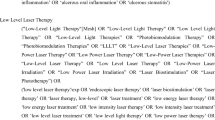Abstract
Background
Low-energy laser (LEL) treatment has been suggested as an effective and safe method to prevent and/or treat oral mucositis induced by chemotherapy and/or radiotherapy; however, it has not gained wide acceptance so far.
Materials and methods
We conducted two clinical trials testing the LEL technique: firstly, as a secondary prevention in patients with various solid tumors treated with chemotherapy who all developed severe mucositis after a previous identical chemotherapy and, secondly, as therapeutic intervention (compared to sham illumination in a randomized way) in patients with hematological tumors receiving intensive chemotherapy and having developed low-grade oral mucositis.
Results
We entered 26 eligible patients in the first study and 36 were randomized in the second study. The success rate was 81% (95%CI = 61–93%) when LEL was given as a preventive treatment. In the second study, in patients with existing lesions, the therapeutic success rate was 83% (95%CI = 59–96%), which was significantly different from the success rate reached in the sham-treated patients (11%; 95%CI = 1–35%); the time to development of grade 3 mucositis was also significantly shorter in the sham-treated patients (p < 0.001).
Conclusion
Our results strongly support the already available literature, suggesting that LEL is an effective and safe approach to prevent or treat oral mucositis resulting from cancer chemotherapy.
Similar content being viewed by others
References
Arun Maiya G, Sagar MS, Fernandes S (2006) Effect of low level helium–neon (He–Ne) laser therapy in the prevention and treatment of radiation induced mucositis in head and neck cancer patients. Indian J Med Res 124(4):399–402
Bensadoun RJ, Ciais G (2002) Radiation- and chemotherapy-induced mucositis in oncology: results of multicenter phase III studies. J Oral Laser Applications 2:115–120
Bensadoun RJ, Franquin J, Ciais G et al (1999) Low-energy He/Ne laser in the prevention of radiation-induced mucositis. A multicenter phase III randomized study in patients with head and neck cancer. Support Care Cancer 7:244–252
Cowen D, Tardieu C, Schubert M et al (1997) Low energy helium–neon laser in the prevention of oral mucositis in patients undergoing bone-marrow transplant. Results of a double blind randomized trial. Int J Radiat Oncol Biol Phys 38:697–703
Elting LS, Cooksley C, Chambers M et al (2003) The burdens of cancer therapy. Clinical and economic outcomes of chemotherapy-induced mucositis. Cancer 98:1531–1539
Finch PW, Rubin JS (2006) Keratinocyte growth factor expression and activity in cancer: implications for use in patients with solid tumors. J Natl Cancer Inst 98:812–824
Genot MT, Klastersky J (2005) Low-level laser for prevention and therapy of oral mucositis induced by chemotherapy or radiotherapy. Curr Opin Oncol 17:236–240
Peterson DE, Bones JB, Petit RG 2nd (2007) Randomized placebo-controlled trial of Saforis for prevention and treatment of oral mucositis in breast cancer patients receiving anthracycline-based chemotherapy. Cancer 109(2):322–331
Pourreau-Schneider N, Soudry M, Franquin JC et al (1992) Soft-laser therapy for iatrogenic muncositis in cancer patients receiving high-dose fluorouracil: a preliminary report. J Natl Cancer Inst 8:358–359
Rosen LS, Abdi E, Davis ID et al (2006) Palifermin reduces the incidence of oral mucositis in patients with metastatic colorectal cancer treated with fluorouracil-based chemotherapy. J Clin Oncol 24:5194–5200
Schubert MM, Eduardo FP, Guthrie KA et al (2007) A phase III randomized double-blind placebo-controlled clinical trial to determine the efficacy of low level laser therapy for the prevention of oral mucositis in patients undergoing hematopoietic cell transplantation. Support Care Cancer 15(10):1145–1154
Scully C, Sonis S, Diz PD (2006) Oral mucositis. Oral Dis 12:229–241
Siddiqui MA, Wellington K (2005) Palifermin in myelotoxic therapy-induced oral mucositis. Drugs 65:2139–2146
Spielberger R, Stiff P, Bensinger W et al (2004) Palifermin for oral mucositis after intensive therapy for hematologic cancers. N Engl J Med 351:2590–2598
Svanberg A, Birgegard G, Ohrn K (2007) Oral cryotherapy reduces mucositis and opioid use after myeloablative therapy—a randomized controlled trial. Supportive Care Cancer 15:1155–1161
Author information
Authors and Affiliations
Corresponding author
Rights and permissions
About this article
Cite this article
Genot-Klastersky, M.T., Klastersky, J., Awada, F. et al. The use of low-energy laser (LEL) for the prevention of chemotherapy- and/or radiotherapy-induced oral mucositis in cancer patients: results from two prospective studies. Support Care Cancer 16, 1381–1387 (2008). https://doi.org/10.1007/s00520-008-0439-8
Received:
Accepted:
Published:
Issue Date:
DOI: https://doi.org/10.1007/s00520-008-0439-8




